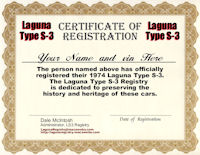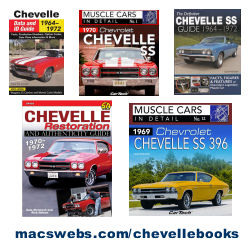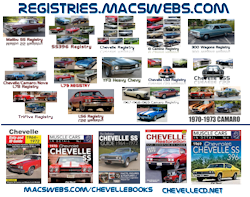Frequently Asked Questions
Q: What's the difference between the Laguna and the Laguna Type S-3?
A: For 1974, the Laguna was renamed Laguna Type S-3 and offered only as the Colonnade Coupe. It retained the urethane front end from 1973 with a revised grille and new parking lamps, augmented at the rear by new taillights. A federally-mandated 5 mph (8.0 km/h) chrome rear bumper replaced the body-colored steel 2.5 mph version from 1973. Standard equipment included a console, a vinyl roof, opera-type vertical rear quarter windows which could be covered with horizontal ribs for a few dollars extra; body side striping, Laguna Type S-3 badging, as well as firmer shocks/springs, a front stabilizer bar, and fat HR70x15 radial tires on Rally wheels. Front occupants rode in swivel bucket seats, and the driver faced a six-dial instrument cluster and a 4-spoke, sport steering wheel. The 1974 Laguna Type S-3 had replaced the discontinued "SS" as the sporty/performance option on the Chevelle. Production totaled 15,792 cars, with prices starting at $3,723 - but with plenty of options to send the bottom line past $5,000. Engine offerings included a standard 145 horsepower 350 two-barrel V8, with optional power plants including a 150 horsepower 400 two-barrel V8, 180 horsepower 400 four-barrel V8 and 230 horsepower 454 four-barrel V8, except in California where a 155 horsepower 350 four-barrel V8 was standard and the 400 and 454 engines were optional. Turbo Hydra-Matic transmission was standard with a four-speed manual available only with the 454 engine.
The 1975 Laguna Type S-3 was introduced mid-year in January 1975. This time, it wore a rakishly slanted, urethane-covered aero-style nose designed for NASCAR and louvered opera windows. The Colonnade designation was dropped. The vinyl half-roof, swiveling Strato-bucket front seats with center console, as well as the four-spoke sport steering were no longer standard S-3 equipment, and were made optional in mid-74 to reduce the car's base price. The 454 engine option was available for the first half of the model year by some accounts after which the 400 engine became the top engine. A GM Confidential Advance Product Information paper states that only the 350 and 400 would be available. The engine line-up was - the standard 145-horsepower 350 two-barrel V8 and the optional 180-horsepower 400 four-barrel V8. If someone can produce verification of the 454 being offered at all in the S-3, we'd welcome the information. All 1975 models included the newly introduced catalytic converter. The Turbo Hydra-Matic 3-speed automatic was the only transmission offered as manual transmissions were discontinued. Options included an Econominder gauge package, affirming again that the age of muscle cars was long gone.
In its third and final production year, the 1976 Laguna Type S-3 again featured a sloped, body-color urethane front end and quarter-window louvers, but with new rear styling and horizontal taillights shared with other Chevelles. Lagunas shared their round-gauge instrument panel with the personal-luxury Monte Carlo; Malibu models made do with a more conventional dashboard and a linear-readout speedometer. The standard engine was a new 140-horsepower 305 2-barrel V8. Optional engines included the 145-horsepower 350 two-barrel V8 and 180-horsepower 400 four-barrel V8. Aero styling had helped make the Laguna popular with NASCAR drivers, but tough good looks weren't enough to lure muscle car prospects into showrooms after V-8 engines had lost their vigor. It was greatly outsold by the Malibu Classic coupe and the Monte Carlo. Production of the Laguna edged up to 9,100 cars as the base price went to $4,621.
There never was a Laguna SS. The SS option (RPO Z15) was discontinued after the 1973 model year and it was only available with the Malibu in 1973, not the Laguna.

 1974 Type S-3 Laguna
1974 Type S-3 Laguna 1975 Type S-3 Laguna
1975 Type S-3 Laguna 1976 Type S-3 Laguna
1976 Type S-3 Laguna








